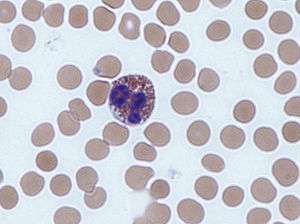Eosinopenia
Eosinopenia is a form of agranulocytosis where the number of eosinophil granulocytes is lower than expected. Leukocytosis with eosinopenia can be a predictor of bacterial infection.[1] It can be induced by stress reactions, Cushing's syndrome, or the use of steroids.[2] Pathological causes include burns and acute infections.
| Eosinopenia | |
|---|---|
 | |
| An eosinophil in peripheral blood | |
| Specialty | Hematology |
See also
References
- Gil H, Magy N, Mauny F, Dupond JL (2003). "[Value of eosinopenia in inflammatory disorders: an "old" marker revisited]". Rev Med Interne (in French). 24 (7): 431–5. doi:10.1016/S0248-8663(03)00138-3. PMID 12829215.
- "Monocytopenia/Eosinopenia/". Archived from the original on 2008-01-16. Retrieved 2008-02-17.
Further reading
- Krause JR, Boggs DR (1987). "Search for eosinopenia in hospitalized patients with normal blood leukocyte concentration". Am. J. Hematol. 24 (1): 55–63. doi:10.1002/ajh.2830240108. PMID 3799595.
This article is issued from
Wikipedia.
The text is licensed under Creative
Commons - Attribution - Sharealike.
Additional terms may apply for the media files.